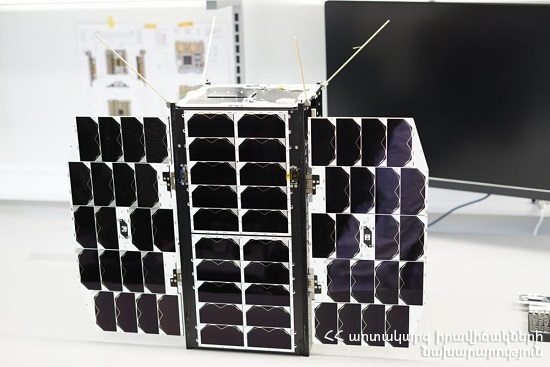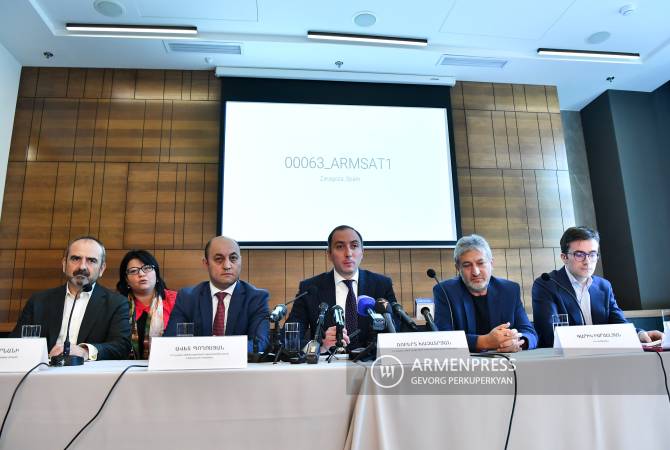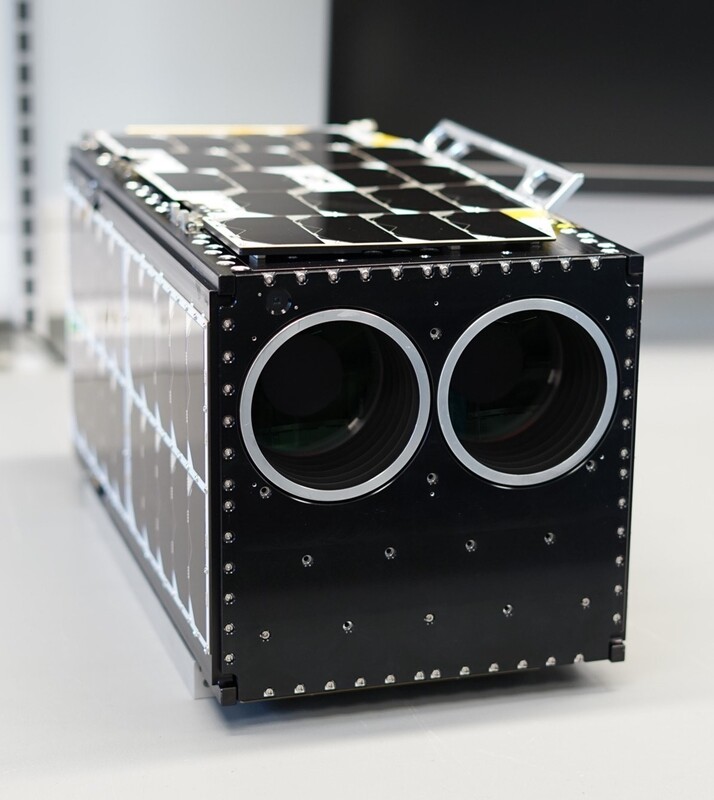
Second Armenian satellite will be Armenian-made
The first Armenian satellite "ArmSat-1" launched on May 25 this year is fully ready for operation, the control center to be created in Armenia will allow fully controlling the satellite from Armenia, Minister of Hi-Tech Industry Robert Khachatryan stated during а press conference dedicated to the operation of the first Armenian satellite on Friday.
"During these six months tests and adjustment of the satellite have been carried out. At the moment we can state that these works have been successfully completed, all subsystems have been tested and the satellite is fully ready for operation," he said.
The Minister noted that currently the works on the construction of the control center are carried out. A working group will soon arrive in Armenia and will start assembling the satellite, most of the equipment has been brought to Armenia and the specialists are making preparations.
Armenian specialists from Armenia will control the satellite
According to the Minister, the control center which will be set up in Armenia will enable to fully control the satellite from Armenia through Armenian specialists. He also stressed that their main goal is the development of Armenia's space capabilities.
"We already have quite a big interest from Armenian companies, which want to take part in this process. More than ten companies have expressed their willingness to participate, each in its own field," he said.
The minister also noted that they want to develop satellite construction in Armenia as well. "It is connected with the sphere of optics, microelectronics, software development, so we consider the construction of satellites very profitable for Armenia. It will give an impetus to the development of several sectors at once," he said. "It's an interesting fact that there were already operating companies in the Republic of Armenia, somehow related to space science, and this project gave us an opportunity to uncover the capabilities of these companies."
Аsked whether the control center and the satellite could be operated and controlled only by the Armenian specialists, Robert Khachatryan said: "As soon as we are sure that we can control the satellite completely by ourselves, the control will be totally in our hands. The data, which has been and will be received, is the property of Armenia, no other country or company has rights to this data.” He also stressed that the control center will be opened before the end of the year, even earlier.
We will quickly move on to the second satellite which will not only be Armenian but also of Armenian production
Deputy Minister High-Tech Industry Avet Poghosyan, who was also present at the press conference, said that the launch of the first Armenian satellite was carried out very quickly, but the achievements accumulated during this time allow us to say that we can start designing the second satellite, which will differ significantly from the first satellite not only in technical characteristics, but also in the fact that a significant part of both design and integration will be produced in Armenia. "It will not only be the second Armenian satellite, but also the first Armenian-made satellite. That is our goal," he said.

Armenia didn't buy an expensive Mercedes, but created a factory which will produce that expensive Mercedes
SATLANTIS Director General Juan Tomás Hernani also spoke about the establishment of the control center in Armenia, noting that in this way Armenia has a possibility to control the satellite by its own forces.
"The control center has two important functions. First, the data are uploaded to the control center and second, this database can be used and applied by the government. The next important consideration is strategic vision. Armenia, figuratively speaking, did not buy an expensive Mercedes, but created a factory that will produce that expensive Mercedes. That's why SATLANTIS set up an Armenian office, where long-term plans will also be presented", he said.
Juan Tomás Hernani also noted that the data received from the Armenian satellite will be used primarily in the sphere of agriculture.

Photo credit - Armenpress
In what spheres it will be possible to use the data received from the Armenian satellite?
Touching upon the spheres of satellite application, Deputy Minister of High-Tech Industry Avet Poghosyan said that the data received from the Armenian satellite can be used in many spheres: agriculture, cadastre cartography, road construction, water resources management, meteorological investigations, prevention of natural calamities in emergency situations, liquidation of natural calamities consequences.
"As for the economic effect, I must say that the space industry field is one of the fastest growing in the world market. According to current data, it has a turnover of about $300 billion and it is planned that in 2030 this number will become $1 trillion. Our goal is for Armenian companies to engage in this market. We are moving forward at great speed and there are preconditions for Armenian companies to take a certain part of the market by 2030," he said.
Astrophysicist Garik Israelyan added that, for example, satellite data can help us understand whether a crop is ripe or not, as well as having moisture data.
"You can see a very small area from drones, and a satellite can transmit data on an incomparably large area. By the way, we are not only talking about the territory of Armenia, we can receive orders from other countries, for example from Brazil."
In his turn, Minister Robert Khachatryan said that the photos and data received from the satellite will not be available for public. "But our partners can apply and we will provide. They will not be in open sources."
The data from the satellite will arrive at the control center in 22 minutes
Javier Ojanguren, Armenian Project Manager at SATLANTIS, introduced the functions of the Armenian Satellite Control Center.
"The activities will be carried out as follows. The executable computer program will completely control the satellite through telecommunication means, which can be downloaded from the satellite. There will be seven different subsystems, through which we will be able to obtain data such as temperature, power consumption, voltage and current, as well as the execution of programmed tasks. Very importantly, we have alarms, and this system will let us know if something is wrong in terms of function performance.
The second item in the mission plan will be the transmission of tasks over the ground networks. Each week the operators will develop a plan that will be reviewed in the medium term so that functions can be changed if necessary. 7-10 launches out of a possible 15 per day will be at the expense of the ground station.

It will take eighteen minutes to perform these operations on Aremnia's territory. Twenty-two minutes will pass before we can get that data. We have that capability because of the satellite's orbit and because of the selected terrestrial network. "An antenna located in Yerevan has been added to the terrestrial network," he said.
Javier Ojanguren showed images taken from the satellite. "We have 100-150 gigabytes of information that we got about planet Earth. We are talking about an area of 12-17 thousand square kilometers per day, which is possible to photograph by satellite," he stressed.
About ArmSat-1
The first Armenian satellite "ArmSat-1" was launched into space in 2022. On May 25, the satellite was launched from the Cape Canaveral Space Station in the U.S. by the SpaceX company. The launch of the satellite took place within the framework of cooperation between Armenian state "Geocosmos" and Spanish SATLANTIS company.
ArmSat-1 satellite will operate for four years. The information provided by ArmSat-1 will be used in border control, emergency situation prevention and management, environmental protection, urban planning, road construction, earth sciences and other areas.
The satellite was originally called "Urdaneta," but was renamed "ArmSat-1" some time later, in 2022 in June.
- Related News
- Could life exist on Saturn's moon Enceladus?
- Why is it so difficult to send people to the Moon today?
- Once in a lifetime phenomenon: This year we will observe a star explosion that occurred 3,000 years ago
- "AMADEE-24" Mars Analog Research Mission in Armash came to an end
- NASA creates new generation solar sail: What is it for?
- Flying object resembling surfboard was detected in Moon’s orbit: What is it in fact?
- Most read
month
week
day
- iPhone users are advised to disable iMessage: What risks are hidden in it? 1613
- Pavel Durov gives interview to Tucker Carlson: From 3-hour interview, less than hour appears in final version 1346
- Armenia takes 89th place in terms of mobile Internet speed, but leads region in terms of fixed line speed 826
- Meta unveils Llama 3 and claims it's the "most powerful" open source language model 802
- Once in a lifetime phenomenon: This year we will observe a star explosion that occurred 3,000 years ago 770
- WhatsApp to integrate AI function: What will it do? 741
- Google fires 28 employees who protested against company's cooperation with Israel 738
- Nokia and Heineken introduce Boring Phone: It does not have social networks and a browser, but it is designed for people over 21 (photo) 730
- Boston Dynamics introduces new version of Atlas robot that is completely electric։ Where will it be applied? 710
- iPhone 17 Plus will have smaller screen 657
- Archive
